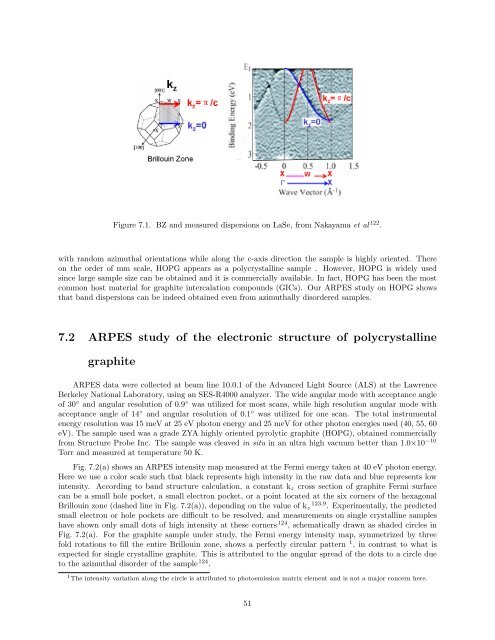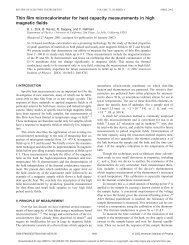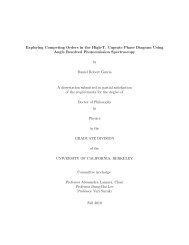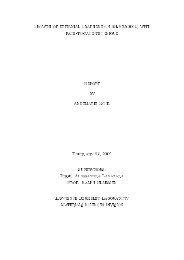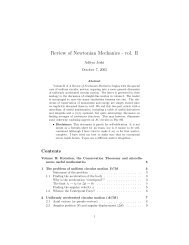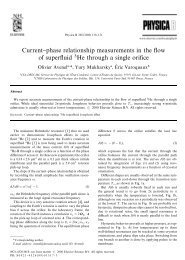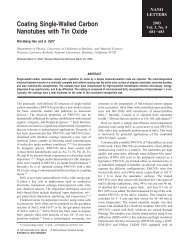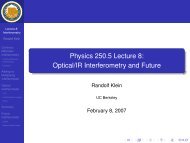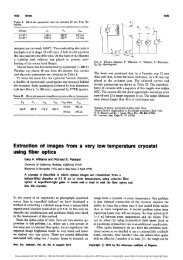Dirac Fermions in Graphene and Graphiteâa view from angle ...
Dirac Fermions in Graphene and Graphiteâa view from angle ...
Dirac Fermions in Graphene and Graphiteâa view from angle ...
You also want an ePaper? Increase the reach of your titles
YUMPU automatically turns print PDFs into web optimized ePapers that Google loves.
Figure 7.1. BZ <strong>and</strong> measured dispersions on LaSe, <strong>from</strong> Nakayama et al 122 .<br />
with r<strong>and</strong>om azimuthal orientations while along the c-axis direction the sample is highly oriented. There<br />
on the order of mm scale, HOPG appears as a polycrystall<strong>in</strong>e sample . However, HOPG is widely used<br />
s<strong>in</strong>ce large sample size can be obta<strong>in</strong>ed <strong>and</strong> it is commercially available. In fact, HOPG has been the most<br />
common host material for graphite <strong>in</strong>tercalation compounds (GICs). Our ARPES study on HOPG shows<br />
that b<strong>and</strong> dispersions can be <strong>in</strong>deed obta<strong>in</strong>ed even <strong>from</strong> azimuthally disordered samples.<br />
7.2 ARPES study of the electronic structure of polycrystall<strong>in</strong>e<br />
graphite<br />
ARPES data were collected at beam l<strong>in</strong>e 10.0.1 of the Advanced Light Source (ALS) at the Lawrence<br />
Berkeley National Laboratory, us<strong>in</strong>g an SES-R4000 analyzer. The wide angular mode with acceptance <strong>angle</strong><br />
of 30 ◦ <strong>and</strong> angular resolution of 0.9 ◦ was utilized for most scans, while high resolution angular mode with<br />
acceptance <strong>angle</strong> of 14 ◦ <strong>and</strong> angular resolution of 0.1 ◦ was utilized for one scan. The total <strong>in</strong>strumental<br />
energy resolution was 15 meV at 25 eV photon energy <strong>and</strong> 25 meV for other photon energies used (40, 55, 60<br />
eV). The sample used was a grade ZYA highly oriented pyrolytic graphite (HOPG), obta<strong>in</strong>ed commercially<br />
<strong>from</strong> Structure Probe Inc. The sample was cleaved <strong>in</strong> situ <strong>in</strong> an ultra high vacuum better than 1.0×10 −10<br />
Torr <strong>and</strong> measured at temperature 50 K.<br />
Fig. 7.2(a) shows an ARPES <strong>in</strong>tensity map measured at the Fermi energy taken at 40 eV photon energy.<br />
Here we use a color scale such that black represents high <strong>in</strong>tensity <strong>in</strong> the raw data <strong>and</strong> blue represents low<br />
<strong>in</strong>tensity. Accord<strong>in</strong>g to b<strong>and</strong> structure calculation, a constant k z cross section of graphite Fermi surface<br />
can be a small hole pocket, a small electron pocket, or a po<strong>in</strong>t located at the six corners of the hexagonal<br />
Brillou<strong>in</strong> zone (dashed l<strong>in</strong>e <strong>in</strong> Fig. 7.2(a)), depend<strong>in</strong>g on the value of k z 123,9 . Experimentally, the predicted<br />
small electron or hole pockets are difficult to be resolved, <strong>and</strong> measurements on s<strong>in</strong>gle crystall<strong>in</strong>e samples<br />
have shown only small dots of high <strong>in</strong>tensity at these corners 124 , schematically drawn as shaded circles <strong>in</strong><br />
Fig. 7.2(a). For the graphite sample under study, the Fermi energy <strong>in</strong>tensity map, symmetrized by three<br />
fold rotations to fill the entire Brillou<strong>in</strong> zone, shows a perfectly circular pattern 1 , <strong>in</strong> contrast to what is<br />
expected for s<strong>in</strong>gle crystall<strong>in</strong>e graphite. This is attributed to the angular spread of the dots to a circle due<br />
to the azimuthal disorder of the sample 124 .<br />
1 The <strong>in</strong>tensity variation along the circle is attributed to photoemission matrix element <strong>and</strong> is not a major concern here.<br />
51


